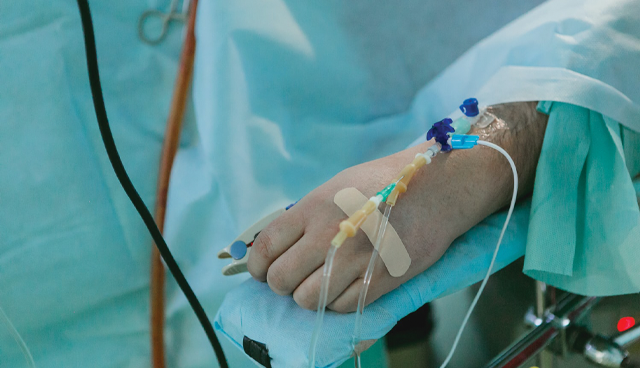Critical care capacity

Since the onset of the Covid-19 pandemic, critical care capacity has come into sharp focus. However, for over a decade, a shortage of capacity in critical care has been highlighted and increases in demand for ICU beds projected.
Critical care is defined by recognition of a patient’s decisive deterioration and the subsequent intervention to provide intensive treatment and close monitoring. Timely critical care greatly enhances the likelihood of survival for a critically ill patient. Critical care is an expensive and finite resource.
Intensive care units (ICUs) are specialist hospital wards staffed by specially trained healthcare professionals who provide treatment and monitoring for critically ill individuals. ICUs and high dependency units (HDUs) may also be referred to as critical care units (CCUs).
The staff to patient ratio for an intensive care bed is 1:1 and for a high dependency bed it is 1:2. A sufficiently staffed ICU bed, therefore, requires an average of 5.6 nurses to provide direct care 24/7. Registered nurses require a minimum of six months’ training to become an intensive care nurse.
“For too long the request of the critical care community for appropriate capacity has been deferred. Serial reports over the past 15 years have consistently documented the inadequacy of critical care capacity in Ireland.”
Open letter to political party leaders from critical care representative organisations in April 2020.
Experts on critical care now refer to ‘levels of care’ when analysing critical care activity. Critically ill patients receive critical care in Level 3 ICU or Level 2 HDU. These are Critical Care Services as defined by the Joint Faculty of Intensive Care Medicine of Ireland (JFICMI).
Founded by the College of Anaesthetists of Ireland; the Intensive Care Society of Ireland; the Royal College of Physicians of Ireland; and the Royal College of Surgeons in Ireland in 2009, the JFICMI produced the National Standards for Adult Critical Care Services 2011 for critical care medicine delivery.
Legacy recommendations
Over the last decade, a series of recommendations have been made with regard to increasing critical care capacity.
- Towards Excellence in Critical Care, a 2009 review of adult critical care services, recommended a 45 per cent increase of critical care beds from 289 to 418. “This will need to increase sequentially to 579 over the period 2010 to 2020,” the Prospectus report stated, adding: “All critical care units should work towards a minimum capacity of eight beds.”
At the time of the report in September 2009, there were 289 funded, open critical care beds in the State and nurse:patient ratios for ICU varied from 1:1 to 1:1.5. This represented 8.71 adult critical care beds per 100,000 of the adult population (aged 16 and over).
Regardless, between, 2008 and 2013, critical care capacity decreased by 32 beds. Indeed, from 2011 to 2013, there was a 7.5 per cent decrease in adult critical care beds and a simultaneous 22 per cent reduction in critical care nurses. When critical care capacity is decreased in central hospitals, the result is inaccessible critical care services and increased risk for critically ill individuals.
- The Critical Care Programme (CCP) is a collaborative initiative administered by National Clinical Programmes, Clinical Strategy and Programmes Directorate, HSE, in partnership with the Joint Faculty of Intensive Care Medicine of Ireland (JFICMI) and Intensive Care Society of Ireland (ICSI). The stated aimed of the CCP is “to improve the survival of critically ill patients” through “critical care performance improvement by strengthening critical care capability”.
A priority for the CCP is the implementation of a model of care for adult critical care. Building on the 2009 Prospectus report, Right Care, Right Now: Model of Care for Adult Critical Care was published in October 2014.
The Model of Care for Adult Critical Care concurred with the recommendations for expansion of critical care services, as set out in the 2009 Prospectus report and adds that “an immediate priority must be to restore the loss of critical care bed capacity since 2008”.
Yet, while the CCP advocates for adult critical care capacity increases, it opposes “a ‘big bang’ approach where a huge increase of 190 beds is ‘packed’ into a couple of years e.g. years 2029, 2030 and 2031 down the road. This latter approach is not feasible or achievable, does not plan to meet the needs of critically ill patients in Ireland today and does not represent a sustainable capacity development strategy”.
Instead, the Critical Care Programme proposes “multi-annual incremental adult critical care capacity increases” to meet the demand of critically ill patients.
- In 2018, the Department of Health’s Health Service Capacity Review Report recommended an 80 per cent increase in national adult critical care bed capacity from 240 beds to 430 by 2031. Likewise, the HSE’s National Services Plan 2019 identified an increase of 16 critical care beds as a requirement to augment adult critical care capacity.
“The number of critical care beds should be increased by 45 per cent from 289 to 418 beds. This will need to increase sequentially to 579 over the period 2010 to 2020.”
— Towards Excellence in Critical Care, Prospectus Report, 2009
Metrics
In 2013, the National Office of Clinical Audit (NOCA) established the Irish National Intensive Care Audit (or ICU Audit) which collects data from 18 ICUs across 15 hospitals. The 2018 audit found that critical care bed occupancy in Ireland was very high, at 88 per cent nationally and up to 96 per cent in specific units. This is significantly higher than the 75 per cent occupancy rate recommended by the European Society of Intensive Care Medicine.
However, this was not unexpected because provision of critical care beds in Ireland (including beds in private hospitals) was 6.0 beds per 100,000 population compared with a European average of 11.5 per 100,000. As such, the major recommendation of the 2018 audit was an increase of bed capacity in adult critical care units (ICU and HDU) towards the 430 beds recommended in the Department of Health’s Health Service Capacity Review 2018.

“In our budget for 2021, there are another 20 beds funded which brings us to 322. All permanent capacity. That’s a significant uplift considering that since 2014, we have been at a static number.”
— Paul Reid, CEO, HSE
Meanwhile, the National Adult Critical Care Capacity and Activity Census Report for 2019 recorded an operational complement of 255 adult critical care beds, incorporating Level 3 ICU and Level 2 HDU beds. This represents a net increase of six adult ICU beds, consolidating increases of seven and eight ICU beds in 2017 and 2018 respectively. In total, HSE Critical Care Census reports have recorded an increase in adult ICU capacity by 21 beds from 2017 to 2019.
In September 2017, a new national ICU nursing workforce planning initiative was launched by then Health Minister Simon Harris TD. Career Pathway or National Postgraduate Specialist Critical Care Nursing Education Training and Integrated Workforce Planning Framework was established by the Critical Care Programme. Through Career Pathway, graduate nurses can now gain immediate access to critical care nursing postgraduate education, training and certification.

“In 2009, the HSE said it needed 579 ICU beds. As I understand it, but the witnesses might confirm the figures on this, we currently have approximately 280. That is a reduction from the 354 beds we had in April. That is very alarming.”
— Richard Boyd-Barrett TD
However, at the time of the 2019 critical care census (30 September 2019), 19 additional adult ICU beds were “non-operational, commissioned critical care beds (funding allocated)” because of a “HSE employment pause”.
“Critical care beds are really about systems of care involving different types of staff.”
— Anne O’Connor, Chief Operations Officer, HSE
Covid-19 pressures
At the outset of the Covid-19 pandemic, the relatively low number of ICU beds was identified as a major challenge. In February 2020, the total ICU beds in the public health system was estimated to be 255, translating to 5.5 ICU beds per 100,000 people.
Consequently, the Government announced that private hospitals would temporarily be incorporated in the public health system as facilitated by a €100 million deal. Simultaneously, public hospitals reconfigured a number of beds that could be utilised as additional ICU beds in the event of an admissions surge.
In April 2020, amid the pandemic, critical care representative organisations penned an open letter to all political party leaders requesting that critical care capacity in Ireland be increased from 5.2 critical care beds per 100,000 people to the European average of 11.5 critical care beds per 100,000 people.
Signed by Catherine Motherway, then President, Intensive Care Society of Ireland; John Bates, Dean, Joint Faculty of Intensive Care Medicine of Ireland; Brian Kinirons, President, College of Anaesthesiologists; Wouter Jonker, Irish Association of Anaesthetists; Michael Power, Clinical Lead, Critical Care Programme; and Serena O’Brien, Chair, Irish Association of Critical Care Nurses, the letter outlined: “Ethically and morally this country must insist that the required expansion in intensive care unit capacity is funded, so we can offer appropriate care to all our critically ill patients and cope with the difficult months ahead. Our pre-pandemic intensive care unit occupancy of 88 per cent nationally and over 96 per cent in major units is well above the international recommended rate of 75 per cent.
“For too long the request of the critical care community for appropriate capacity has been deferred. Serial reports over the past 15 years have consistently documented the inadequacy of critical care capacity in Ireland.”
While additional funding in March 2020 from brought the base adult critical care bed numbers from 257 adult beds (197 Level 3 and 60 Level 2) to 285 (239 Level 3 and 46 Level 2), still 145 beds short of the HSE own recommendation of 430 beds by 2031 and 294 beds short of the 2009 Prospectus report target of 579 critical care beds by 2020.
HSE figures
In September 2020, appearing before the Oireachtas Special Committee on Covid-19 Response, HSE CEO Paul Reid was questioned in relation to ICU capacity. During the sitting, Richard Boyd-Barrett TD highlighted: “In 2009, the HSE said it needed 579 ICU beds. As I understand it, but the witnesses might confirm the figures on this, we currently have approximately 280. That is a reduction from the 354 beds we had in April. That is very alarming. We are far short of a target set in 2009 before the advent of Covid-19. We are significantly down from the figures we had in April and let us remind ourselves that in April, the hospitals were providing ICU in theatre recovery areas. The additional capacity we had was completely surge based and unsustainable in the long run.”
In response, the HSE CEO explained: “On ICUs, this is important, and we need to help clarify it for the public. The total number of ICU beds in March before this pandemic started was 225. We put in place some further funding. The Deputy is correct; the number today is 280 and it was 225. An extra 30 beds were funded by Government and further beds were put in place with the pandemic funding. This brought the number up to 280 today, an increase of about 25 per cent since February. Separately, we have funding for an extra 17 beds in the winter plan. That will bring us close to 300, which would be about a 30 per cent increase on our February figure.”
“A ‘big bang’ approach where a huge increase of 190 beds is ‘packed’ into a couple of years… is not feasible or achievable, does not plan to meet the needs of critically ill patients in Ireland today.”
— Right Care, Right Now: Model of Care for Adult Critical Care, 2014
At the same committee meeting, HSE Chief Operations Officer, Anne O’Connor added: “We are trying to build the more long-term sustainable critical care capacity… Critical care beds are really about systems of care involving different types of staff.”
This was supported by the HSE’s Chief Clinical Officer, Colm Henry, who asserted: “We need to be very clear that when we talk about beds and surge numbers, critical care is a system of care; it is not just counting beds.
“The surge figures in April involved critical care that could potentially have been delivered outside established, conventional critical care units. With regard to the outcomes in our critical care units during the first phase, 79 per cent of patients were discharged alive. This compares very favourably internationally, even though the patient selection was similar.
“The reason, according to our own critical care community, is that most of the care was delivered in established critical care units by our own staff, and not by leaning heavily into surge capacity. To go back to what my colleagues have said, what is important for us, rather than talking about surge capacity, is building up on staffed, funded intensive therapy unit beds and the associated training so we can continue to deliver those excellent outcomes.”
“We need to be very clear that when we talk about beds and surge numbers, critical care is a system of care; it is not just counting beds.”
— Colm Henry, Chief Clinical Officer, HSE
As of late October 2020, the fully staffed ICU bed capacity in Ireland was 285, with a temporary surge capacity of 360. This total is an increase of 30 beds from 255 at the outset of the pandemic. Speaking with eolas Magazine in October, Reid outlined: “We have another 17 to have in place by January as part of our Winter Plan which will bring us to 302. In our budget for 2021, there are another 20 beds funded which brings us to 322. All permanent capacity. That’s a significant uplift considering that since 2014, we have been at a static number.”
Even with such increases, critical care capacity in Ireland will remain significantly below the recommended increase of 579 beds by 2020 contained in the 2009 Prospectus report.





